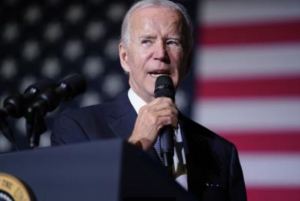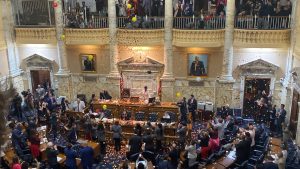By David Carr,
Word in Black
On Jan. 16, the United States celebrated Martin Luther King Jr. ‘s birthday and paid homage to the civil rights leader who helped move the nation to live up to its potential.
While much has been written about King’s community organizing, his guidance in the Southern Leadership Conference, and his amazing rhetorical skills, we still have much to learn about the civil rights leader who dared to dream. It is not widely known that while King obviously was serious about securing civil rights for African Americans and healing the wounds and divisions between Black and White, he was also a vocal and proud supporter of Native American civil rights.
King specifically advocated for the desegregation of Native Americans and inspired much of the modern-day movement for Native rights, including water rights and tribal sovereignty.
In his 1963 book, “Why We Can’t Wait,” King did not hold back with it came to his feelings on the treatment of Native Americans by the U.S. government:
“Our nation was born in genocide when it embraced the doctrine that the original American, the Indian, was an inferior race. Even before there were large numbers of Negroes on our shores, the scar of racial hatred had already disfigured colonial society. From the sixteenth century forward, blood flowed in battles of racial supremacy. We are perhaps the only nation which tried as a matter of national policy to wipe out its Indigenous population. Moreover, we elevated that tragic experience into a noble crusade. Indeed, even today we have not permitted ourselves to reject or feel remorse for this shameful episode. Our literature, our films, our drama, our folklore all exalt it.”
In the late 1950s, King collaborated with the tribal leaders of the Poarch Band Creek Indians. He helped them work towards desegregating their schools in southern Alabama. The tribe reached out to King after learning of his desegregation campaign in Birmingham. He immediately became involved.
At the time, lighter-skinned Native children were allowed to ride school buses and attend desegregated, previously all-white schools, but darker-skinned Native children from the same band were not allowed to ride those same buses, even if the children were all coming from the same household.
With King’s intervention, Native children from the Poarch band were allowed to ride the buses no matter their skin color, marking a major step toward desegregation. As quiet as it’s kept, at the 1963 March on Washington, there was a large Native American contingent, including many from South Dakota.
Moreover, the civil rights movement inspired the Native American rights movement of the 1960s and 70s, along with many of its leaders. This includes but is not limited to the takeover of The Bureau of Indian Affairs Office, the occupation of Alcatraz Island by the Indians of All Tribes, and the second siege at Wounded Knee staged by the Oglala Sioux Nation and The American Indian Movement (AIM).
John E. Echohawk, a member of the Pawnee Tribe, is an attorney and has been a leader of the Native American self-determination movement for more than three decades, thanks to the influence of King. In 1970, Echohawk organized the Native American Rights Fund (NARF), which was modeled after the NAACP’s Legal Defense and Education Fund.
For the past 30 years, NARF has served as a political advocate and legal defender of Native American tribal nations in cases pertaining to tribal sovereignty and treaty enforcement; land, water, and fishing rights; religious and cultural freedoms; and issues of taxation, gaming, and Indian trust monies.
At the 24th Navajo Nation Council in 2020, speaker Seth Damon commended King for remembering the plight of Native Americans and the genocide perpetrated against Indigenous Peoples of this land by the country’s founders. Damon said, “We honor the life and death of Martin Luther King. He was not only a champion and leader for Black people, but Native Americans everywhere.”
It’s easy to compartmentalize Martin Luther King Jr. into one movement, to one type of message, and to one specific cause. In an age that celebrates misinformation and dismisses historical facts, it becomes easy to overlook specific instances of historical intersectionality and understanding.
The truth is King was a true leader when it came to the fight for civil rights for African Americans. He was a firebrand when it came to getting rid of segregation laws, but he was also adamantly opposed to the Vietnam war, and he became immersed in the idea of economic civil rights.
He organized with Miles Horton in the Appalachians, strategized with leaders in the Chicano civil rights movement, and, yes, he was a vocal supporter of Native American civil rights.
As we remember King on his birthday this year, let’s truly try and remember his ENTIRE legacy. Let us look at the ties he created amongst all peoples during the most turbulent of times. Let us remember his legacy of justice, dignity, humanity, and intersectionality. Let’s celebrate the ongoing idea of making his often-spoken-of dream a reality for all.
David Carr has been in public education for 29 years. He is currently a Professional Services Manager at Achieve 3000/McGraw Hill. Before landing at McGraw Hill, he was the principal of LA’s Promise Charter Middle School #1. He started his career as a Teach for America corps member teaching English Language Development at Compton High School, where he taught for five years.
This post originally appeared on WordInBlack.com.
The opinions on this page are those of the writers and not necessarily those of the AFRO. Send letters to The Afro-American • 233 E. Redwood Street Suite 600G
Baltimore, MD 21202 or fax to 1-877-570-9297 or e-mail to editor@afro.com
Help us Continue to tell OUR Story and join the AFRO family as a member –subscribers are now members! Join here!
The post It’s time to know the true history of Dr. King and Native Americans appeared first on AFRO American Newspapers .











